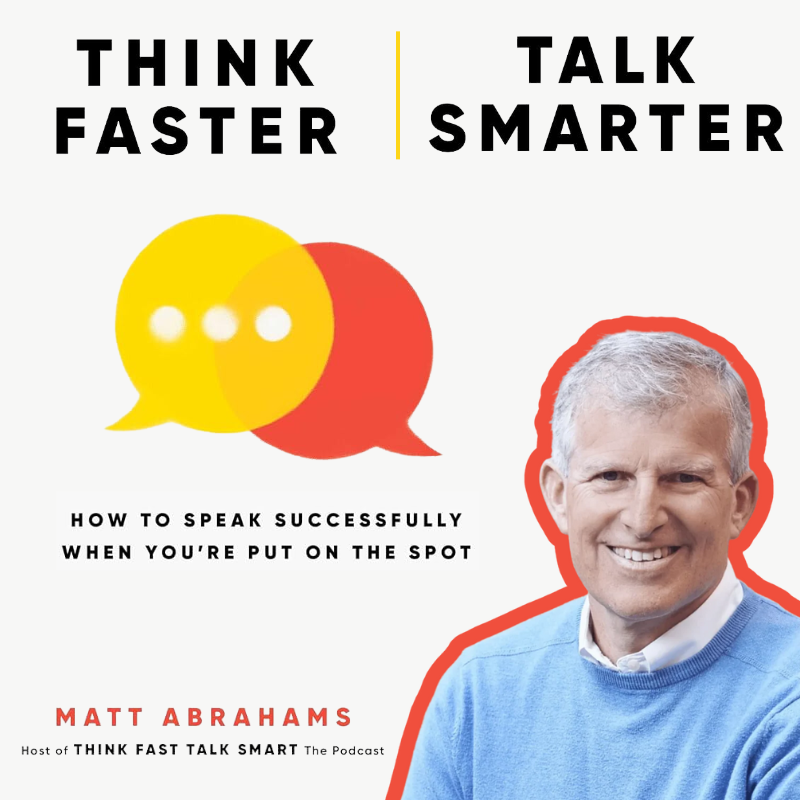In today's fast-paced business world, CMOs face a whirlwind of high-stakes, spontaneous communication situations—from impromptu board meetings to unexpected client calls. Yet many lack formal training in handling these high-stakes moments.
Enter Matt Abrahams, Stanford lecturer and author of "Think Faster, Talk Smarter," who joined a CMO Huddles Career Huddle to share actionable strategies for mastering off-the-cuff communication.
Abrahams argues that while we can't predict every spontaneous scenario, we can prepare ourselves to think and respond more effectively in the moment. Here are five key strategies from his approach:
1. Embrace Structures for Spontaneity
It may sound counterintuitive, but go-to communication structures can actually enhance your ability to be spontaneous. Abrahams recommends the "What, So What, Now What" framework as a versatile tool, the "Swiss Army knife of communication."
- What = Start by clearly stating your idea or issue
- So What = Explain why it matters to your audience
- Now What = Conclude with next steps or actions to take
This simple structure helps organize thoughts quickly and ensures you deliver a clear, relevant, and actionable message.
2. Employ the ADD Technique for Interviews
When facing unexpected interview questions, Abrahams recommends the ADD method.
- A = Start by providing a concise Answer to the question at hand.
- D = Offer supporting Detail or examples to reinforce your point.
- D = Describe how your response relates to the role or company.
This structure ensures comprehensive answers while maintaining relevance. Importantly, Abrahams cautions against over-explaining mistakes. Instead, focus on how you resolved issues and the valuable lessons learned from the experience. This approach demonstrates growth and problem-solving skills, key attributes that interviewers often seek.
3. Manage Anxiety Through Mindset and Technique
High-stakes spontaneous situations often trigger anxiety, which can derail our communication. Abrahams suggests reframing these moments as opportunities for connection rather than threats. Practically, he recommends deep belly breathing—think yoga or tai chi—with longer exhalations to calm your physiology. For mental focus, try present-oriented activities like taking a quick walk or listening to music before important conversations.
4. Practice Active Listening: Pace, Space, Grace
Abrahams emphasizes that effective spontaneous communication isn't just about talking—it's equally about listening. He recommends the "Pace, Space, Grace" approach to enhance your listening skills.
- Pace = Match the speaker's tempo and energy to create rapport.
- Space = Allow for pauses and reflection, giving both you and the speaker time to process information.
- Grace = Be patient and open-minded, even when faced with differing viewpoints.
By honing these listening skills, you'll be better equipped to respond thoughtfully and appropriately in any situation, turning spontaneous conversations into opportunities for meaningful dialogue.
5. Listen Deeply, Then Paraphrase
Effective spontaneous communication starts with active listening. Abrahams advises slowing down and giving yourself the mental space to truly hear not just the words, but the intent behind them. Before responding, try paraphrasing the question or statement back. This demonstrates you've listened carefully and buys you valuable time to formulate a thoughtful response.
6. Prioritize Connection Over Perfection
Many of us put immense pressure on ourselves to deliver the "perfect" response, especially in professional settings. Abrahams advocates for "maximizing mediocrity" instead. By focusing less on self-judgment and more on genuine connection with your audience, you free up mental bandwidth to communicate more naturally and effectively.
7. Course-Correct Gracefully
Even with preparation, we sometimes find ourselves rambling or off-track. Instead of apologizing or drawing attention to the misstep, Abrahams suggests subtle pivots. Try asking a question to refocus the conversation or briefly summarize your main point to get back on track. Here are some examples of transitional phrases to realign your message:
- "The key point here is..."
- "What's most important to understand is..."
- "Let me circle back to the main idea..."
Remember, most people won't notice small fumbles unless you highlight them.
By implementing Abrahams’ strategies, marketing leaders can transform potentially stressful impromptu moments into opportunities for impactful connection and influence.
In this unpredictable world of marketing leadership, you never know when you'll be asked to peel back the layers of your professional onion. So continue to practice and prepare for spontaneous communication, because the next conversation could be your moment to shine—whether you're describing your third layer or crafting a compelling vision for your brand's future.
CMO Huddles features private Q&As (“Career Huddles”) with thought leaders like Matt Abrahams every month. If you’re a B2B marketing leader and want to join the next one, reach out to support@cmohuddles.com for more info.

